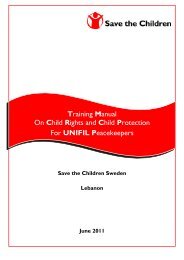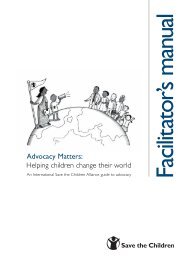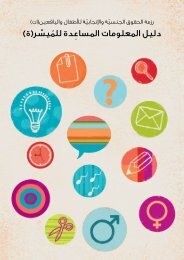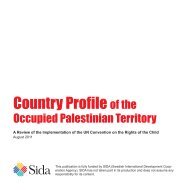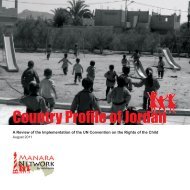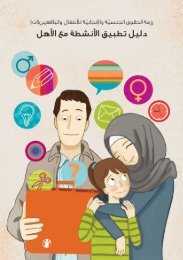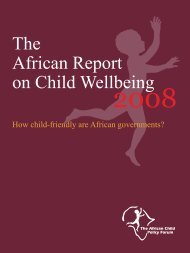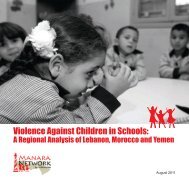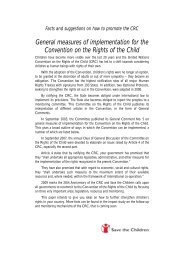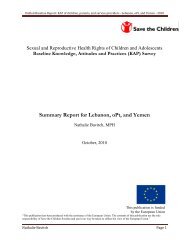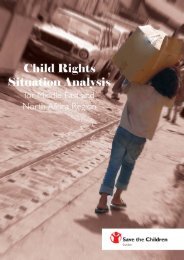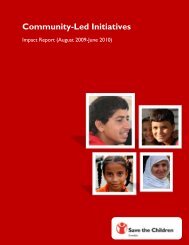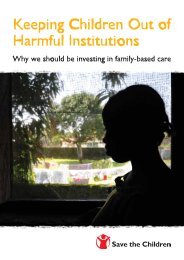Country Profile of Morocco - International Bureau of Children's Rights
Country Profile of Morocco - International Bureau of Children's Rights
Country Profile of Morocco - International Bureau of Children's Rights
Create successful ePaper yourself
Turn your PDF publications into a flip-book with our unique Google optimized e-Paper software.
j.<br />
29<br />
Regional Bodies<br />
Since <strong>Morocco</strong> is located between two geographic areas,<br />
Africa and the Middle East, the regional bodies at work in<br />
its sphere include the African Union, the Arab Maghreb<br />
Union and the Arab League.<br />
<strong>Morocco</strong> is not part <strong>of</strong> the African Union and the Arab<br />
Maghreb Union is currently experiencing difficulties<br />
threatening its operations. The Arab League, to which<br />
<strong>Morocco</strong> does belong, has no real involvement in the<br />
issue <strong>of</strong> child rights. <strong>Morocco</strong> does participate actively in<br />
activities organised by the NOCR 96 and the Arab Council<br />
for Childhood and Development (ACCD).<br />
4. Identifying Child <strong>Rights</strong><br />
Commendable Practices in<br />
light <strong>of</strong> the CRC’s Main Principles<br />
i.<br />
The Right to Non-Discrimination (Article 2)<br />
The Family Code revised in 2004 addressed the issue <strong>of</strong><br />
non-discrimination as recommended by the Committee<br />
in its last Concluding Observations. The Family Code<br />
uses the term “child”—meaning boys and girls—and has<br />
revised text where gender discrimination persisted before.<br />
The age <strong>of</strong> marriage (Section 19) is now 18 years for<br />
both boys and girls. The age <strong>of</strong> majority (Section 209)<br />
is now the same for both genders. Moreover, the Family<br />
Code now provides for the transmission <strong>of</strong> Moroccan<br />
citizenship to any child born <strong>of</strong> a Moroccan mother and a<br />
foreign national father, an issue that had been criticized by<br />
the Committee.<br />
a.<br />
Gender<br />
Girls’ enrolment rate in primary and secondary school<br />
has visibly improved in recent years, going from 61.8%<br />
in 1997/98 to 90.1% in 2005/2006. The number <strong>of</strong> girls<br />
enrolled in primary school in urban areas has gone from<br />
81.5% to 92.9% and from 44.6% to 87.6% in rural areas<br />
over the same period. 97 However, enrolment rates for girls<br />
in secondary school are only 44% total: 37.6% in rural<br />
areas and 47.15% in urban areas.<br />
Several government initiatives have been established to<br />
address the glaring lack <strong>of</strong> schooling for girls. Among<br />
them is an initiative started by the United States Agency<br />
for <strong>International</strong> Development (USAID) in collaboration<br />
with the Committee to Support Girls’ Education (CSGE),<br />
which aims at providing scholarships for girls in rural<br />
areas to continue their schooling. With the support <strong>of</strong> a<br />
scholarship programme, “Une bourse pour réussir” (“Scholarship<br />
for Success”), the CSGE created rural education<br />
centres where young girls are provided with the means to<br />
continue their studies. Between 1999 and 2010, 2,133 girls<br />
received these scholarships. 98<br />
b.<br />
Birth Out <strong>of</strong> Wedlock<br />
The number <strong>of</strong> births outside <strong>of</strong> wedlock is increasing;<br />
although exact figures have yet to be published, the<br />
subject being taboo in <strong>Morocco</strong>. This issue was raised by<br />
the Committee in response to the government’s second<br />
periodic report, stating that “any discrimination based on<br />
gender and birth in all fields <strong>of</strong> civil, economic, political,<br />
social and cultural life” should be removed. 99<br />
Trends in civil society are to recognise births out <strong>of</strong> wedlock,<br />
thereby allowing the child to be de facto recognised,<br />
even if the father is unknown. In fact, through the Family<br />
Code reform <strong>of</strong> 2004, the law now recognises filiation




